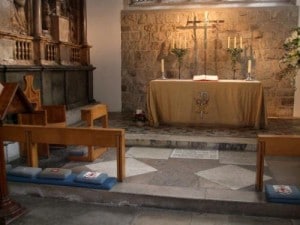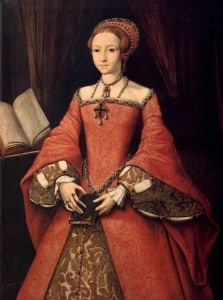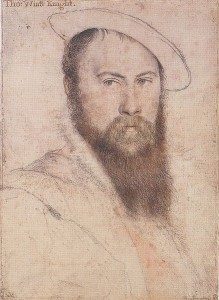
In my previous article, “Anne Boleyn’s Remains – The Exhumation of Anne Boleyn”, I wrote about the restoration of St Peter ad Vincula Chapel in 1876 and the exhumation of the bodies in the chancel, including that of Anne Boleyn. But did the skeleton found actually belong to Anne Boleyn? Alison Weir1 thinks not.
No, it’s not Anne Boleyn
In her book, “The Lady in the Tower”, Alison Weir discusses the findings of the Victorians and the records of Dr Mouat, the doctor who examined the remains found in November 1876, and argues that the Victorians made a mistake. Dr Mouat2 gave the skeleton’s age as between 25 and 30 years of age and described the woman as having a “square, full chin”, but Alison Weir points out that not only does this description not tally with the widely accepted birthdate of 1501 (and therefore an age of 35), it also does not match Anne Boleyn’s appearance. Alison Weir writes:-
“It is just possible that the bones thought to be Anne Boleyn’s – the diminutive slender female with a square jaw – actually belonged to Katherine Howard, miniatures of whom by Holbein show her with what could be a jutting square jaw.”3
Weir goes on to look at the descriptions of another skeleton found in the place where Catherine Howard and Lady Rochford were thought to have been buried. Dr Mouat recorded that these bones belonged to a female of “rather delicate proportions” and “about thirty to forty years of age” and identifies them as belonging to Jane Boleyn, Lady Rochford. Weir concludes that these bones are more likely to belong to the 35 year old Anne Boleyn, rather than Lady Rochford who was probably born around 1512, and that “we can be almost certain that Anne’s memorial stone does not mark the last resting place of her actual remains, and that she lies beneath Lady Rochford’s memorial.”4
Yes, it is Anne Boleyn
Doyne C Bell, author of 1877 “Notices of the Historic Persons Buried in the Chapel of St Peter ad Vincula in the Tower of London, With an Account of the Discovery of the Supposed Remains of Anne Boleyn”, Secretary to Her Majesty’s Privy Purse and member of the committee undertaking the restorations of the chapel, drew up his plan of the resting places of Anne Boleyn and others in the chancel based on “consulting various historical authorities”. The fact that this body was found exactly where Bell’s plan showed Anne Boleyn to be buried and “no other female bones were found on this spot”5 makes me think that they do belong to Anne. The bones belonging to a 35-40 year old female were found in the grave where Catherine Howard and Lady Rochford were said to have been buried, so couldn’t that body be that of Lady Rochford?

Obviously if you believe that Anne was born in 1507, then Dr Mouat’s description of the skeleton belonging to a 25-30 year old woman makes sense as Anne would have been 28/29 when she was executed. If you believe in a 1501 birthdate then Anne was 34/35 when she was executed so it’s slightly out, but then the Victorians did not have access to the same technology that we have today. One feature of the skeleton that really does make me think of Anne Boleyn is the description of the hands:-
“delicate and well-shaped hands and feet, with tapering fingers and a narrow foot.”6
We know that Elizabeth I was proud of her long, elegant fingers (see the portrait of Princess Elizabeth) and I am convinced that she inherited these from her mother, Anne Boleyn.
As far as the argument over the “square, full chin is concerned”7, it depends on which portrait of Anne Boleyn you believe to be most accurate. The “Anne Boleyn after Holbein” portrait (from Hever Castle) that I used to illustrate Monday’s article and the Victorian engraving based on it, show Anne with a squarish chin, as do the Holbein sketches. I personally believe that the Hever rose and NPG portraits are closest to what Anne Boleyn looked like and although they show her with a pointed chin, Dr Mouat’s description described the face as being oval and perhaps the portrait lengthened Anne’s chin slightly – who knows? It is hard to know exactly how square and full Dr Mouat meant and we obviously don’t know for sure exactly what Catherine Howard or Lady Rochford looked like.
Also, if Lady Rochford was “born in 1512 at the latest”8 and was executed in 1542, then she would have been aged at least 30 when she died, probably older as that would have made her only 12 in 1524 when she got married. Julia Fox9, Jane Boleyn’s biographer puts Jane’s year of birth at 1505, which would make Jane 37 years old when she died, so it makes sense that the bones of a 35-40 year old, found in the grave where she and Catherine Howard were recorded to have been buried, did indeed belong to Jane Boleyn, Lady Rochford.
My conclusion is that there is no reason to think that the Victorians were wrong in their identification of Anne Boleyn’s remains. I know that their identification relied on circumstantial evidence, the fact that the body lay where they expected to find Anne Boleyn, but there is no hard evidence to suggest that it wasn’t Anne. Whatever the real truth of the matter, Anne Boleyn was buried in the chancel, next* to her beloved brother, George, so even if she’s not directly under that tile, she is not far away. John Bayley, the 19th century author of “The History and Antiquities of the Tower of London” writes:-
“In front of the altar, repose the beauteous Anna Boleyn, and the guilty Catherine Howard, two ill-fated wives of Henry VIII: the former suffered in 1536, under charge of adultery not clearly proved; and the latter, upon full conviction of the same crime, in 1541. Here also sleeps the headless body of George lord Rochford, the innocent brother of the former. Involved in her accusation, he preceded, by two days, his unfortunate sister to the grave, as his infamous wife, a principal instrument in their death, accompanied, unpitied, her mistress, Catherine Howard, in execution and in sepulture.”10
I have seen it written online that Anne Boleyn’s bones were identified as Anne because they were mixed up with pieces of the elm chest that she was buried in, but this is not true. The records from 1876 make no mention of any pieces of elm wood being found with the bones and I am not sure that you’d expect to find any remains of a wooden box 340 years on.
*Alison Weir11 writes of how Yeoman Warder, Geoffrey Abbot, who has written several books on the Tower, suggests, from the information of an uncited Tudor source, that actually George and Anne Boleyn were buried at opposite ends of the vault and that Lady Rochford was buried next to her husband. Agnes Strickland writes of how Anne “was thrust into a grave that had been prepared for her by the side of her murdered brother”12.
Other Possible Burial Sites

There are a few legends regarding the resting place of Anne Boleyn, with some people believing that her body is not in the Tower of London at all:-
- Salle Church, Norfolk – Agnes Strickland writes of the “curious tradition” from Anne Boleyn’s “native Norfolk” which tells of how Anne’s remains were secretly removed from the Tower of London at night, taken to Salle Church, “the ancient burial place of the Boleyns, and there interred at midnight, with the holy rites that were denied to her by her royal husband” under an unmarked slab of black marble. Although Strickland states that there is no evidence to support this legend, she does quote Sir Thomas Wyatt: “God provided for her corpse sacred burial, even in a place as it were consecrate to innocence” , saying that this could suggest that Wyatt was in on the secret and had something to do with the removal of Anne’s remains.
In her book “Anne Boleyn”13, Norah Lofts writes of how she visited Salle Church and was shown the black marble slab by the sexton. She asked if it had ever been lifted and was told that the patron of the church was not in favour of having it lifted for investigation. The sexton also told her that Anne was said to “walk” the church every year on the night of the anniversary of her execution and that one year on the 19th May he had been keeping vigil when “a great hare” appeared in the church and led him “a fine chase”. Lofts explained to the man that a hare was one of the forms that a witch was supposed to be able to turn into at will and Anne “was supposed to be a witch.” What nonsense!
Alison Weir writes of how the Salle Church myth was debunked when the slab at the church was lifted and nothing was found underneath it14 but an article entitled “Where was Anne Boleyn Buried?”15 on the Reepham Benefice website (the benefice of Salle Church) makes no mention of the slab ever being lifted. - Horndon-on-the-Hill, Essex – Agnes Strickland also tells of this legend, saying that “in the ancient church of Horndon-on-the-Hill in Essex, a nameless black marble monument is also pointed out by village antiquaries as the veritable monument of this queen.”16 Strickland thinks that this legend and the Salle Church legend grew out of “rumours of the murdered queen’s removal from the Tower chapel” which “were at one time in circulation among the tenants and dependants of her paternal house, and were by them orally transmitted to their descendants as matter of fact.”
- St Mary’s Church, Erwarton, Suffolk – According to legend, Henry VIII and Anne Boleyn often stayed at Erwarton Hall in Suffolk and Anne loved the place so much that she gave instructions that her heart should be buried in the local church. During renovations at the local St Mary’s Church in 1838, a heart-shaped casket was found set into an alcove in the north aisle and legend has it that Sir Philip Parker of Erwarton Hall, Anne’s uncle, was the one who buried Anne’s heart there. The casket was then reburied beneath the organ and a plaque states that Anne Boleyn’s heart is buried there.17 Alison Weir writes of how this legend is unlikely because heart burial was only fashionable until the end of the 14th century (yet it is said that Henry VIII buried Jane Seymour’s heart in the Chapel Royal at Hampton Court Palace), and the uncle’s name is wrong. Anne’s aunt, Amata Boleyn was married to Sir Philip Calthorpe. Whatever the truth of the matter, the village pub is called “The Queen’s Head”!
What do you think? Do you think that Anne Boleyn is beneath that memorial tile or do you think she lies beneath that of Lady Rochford? Or, is she somewhere else entirely?
Note: Many people are under the impression that all of the remains found during the Victorian restorations were buried together in a mass grave. This is not true. The seven sets of bones found in the chancel were identified and re-interred in separate, labelled boxes under the chancel floor and given memorial tiles. The remains found in the main part of the church, of which there were many, were collected, taken to the crypt “and enclosed in boxes, with suitable descriptions.” Queen Victoria was saddened by the findings of the restoration team, who found that coffins had been deliberately broken up in the past to make room for new “occupants”, and only gave her blessing to the restoration plans “with the express condition that the greatest care and reverence should be exercised in this removal, and that a careful record should be kept of every sign of possible identification which might come to light.”18 The Victorians did their best to treat the remains with respect, though of course they did not raise the whole floor.
Notes and Sources
- The Lady in the Tower, Alison Weir
- The findings of Dr Frederick Mouat published in “Notices of the Historic Persons Buried in the Chapel of St Peter ad Vincula in the Tower of London, With an Account of the Discovery of the Supposed Remains of Anne Boleyn” by Doyne C Bell, 1877
- Alison Weir, p326
- Ibid., p327
- Doyne C Bell, p21
- Dr Mouat in Bell, p26
- Ibid.
- Weir, p326
- Jane Boleyn: The True Story of the Infamous Lady Rochford, Julia Fox, p8
- The History and Antiquities of the Tower of London, John Bayley, 1821, p120
- Weir, p324
- Lives of the Queens of England: From the Norman Conquest – Volume 2, Agnes Strickland, p700
- Anne Boleyn, Norah Lofts, p183-185
- Weir, p323
- Where was Anne Boleyn Buried?, Reepham Benefice Website
- Strickland, p701
- The St Mary’s Church, Erwarton website
- Bell, p16
Photo by Paudie Kennelly